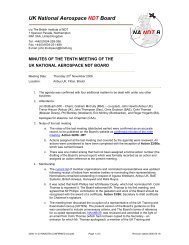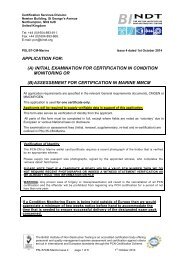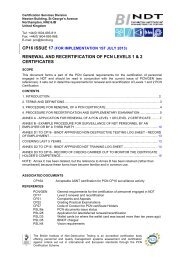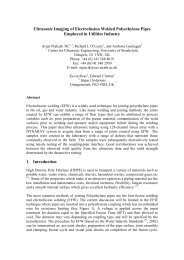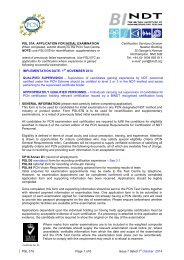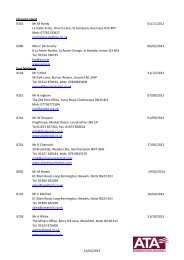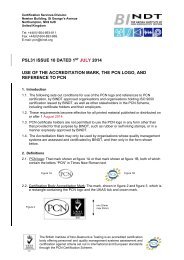Development of a laser-based weld flaw identification system - BINDT
Development of a laser-based weld flaw identification system - BINDT
Development of a laser-based weld flaw identification system - BINDT
Create successful ePaper yourself
Turn your PDF publications into a flip-book with our unique Google optimized e-Paper software.
<strong>Development</strong> <strong>of</strong> a <strong>laser</strong>-<strong>based</strong> <strong>weld</strong> <strong>flaw</strong> <strong>identification</strong> <strong>system</strong>Zhigang Qu, Abdeldjalil Bennecer, Cem Selcuk and Tat-Hean GanBrunel Innovation Centre, Brunel University,Uxbridge, Middlesex, UB8 3PH, UKTelephone: 0044(0)1223899125E-mail: Zhigang.qu@brunel.ac.ukAbstractIn this paper, a <strong>laser</strong>-<strong>based</strong> <strong>flaw</strong> <strong>identification</strong> <strong>system</strong> is presented for non-destructiveinspection <strong>of</strong> <strong>weld</strong>s. The <strong>laser</strong> sensor design is <strong>based</strong> on the <strong>laser</strong> triangulation principleand the output is a two-dimensional pr<strong>of</strong>ile <strong>of</strong> a target sample, which contains basicdimensional information: height and width <strong>of</strong> the <strong>weld</strong>. This two-dimensional pr<strong>of</strong>ile isthen processed by a specially devised algorithm <strong>based</strong> on the local maxima <strong>of</strong> the sym8wavelet coefficients accumulation. The positions <strong>of</strong> artificially created features (notchesrepresentative <strong>of</strong> <strong>weld</strong> <strong>flaw</strong>s such as surface breaking cracks) on the sample are therebycalculated. It is shown that the <strong>laser</strong>-<strong>based</strong> <strong>weld</strong> <strong>flaw</strong> <strong>identification</strong> <strong>system</strong> is able toreliably and accurately identify and locate surface features ⅓ mm wide.1. IntroductionWelding plays a fundamental role in many modern manufacturing industries, such asship building, machinery manufacturing, railway and pipeline construction, etc. Thepotential <strong>weld</strong> <strong>flaw</strong>s can significantly deteriorate the reliability <strong>of</strong> products. Therefore,in order to identify the possible presence <strong>of</strong> <strong>weld</strong> <strong>flaw</strong>s, different NDT inspectionmethods are studied and developed for essential quality control.Generally, those methods include penetrant testing (PT) (1) , eddy current testing (ECT)(2) , radiographic testing (RT) (3) , ultrasonic testing (UT) (4) , magnetic particle inspection(MPI) (5) , alternating current field measurement (ACFM) (6) and vision-<strong>based</strong> inspection.PT (1) can detect surface <strong>flaw</strong>s on both ferrous and non-ferrous metal materials with highsensitivity. However, high levels <strong>of</strong> surface preparation and cleanliness are required andthere are some health and safety issues as well. Additionally, only a relativelynonporous surface material can be inspected. ECT (2) is able to detect <strong>flaw</strong>s inconductive materials, which is excellent in examining continuously <strong>weld</strong>ed tubes as inthe oil and gas industry but only conductive materials can be tested. Also <strong>flaw</strong>s lyingparallel to the probe may be undetectable. Furthermore, the finish <strong>of</strong> the material mightinterfere with inspection readings. RT (3) is a widely used testing method to detect bothinternal and surface <strong>flaw</strong>s for most work pieces with very high sensitivity. However,this method needs well trained operators together with significant cost and safety issues.UT (4) is convenient, inexpensive and well established but requires highly skilledoperators to interpret the results, and rough surfaces tend to cause scattering whichresults in an increased noise detected by the receiver, thus reducing the probability <strong>of</strong>detection. Moreover, it is very difficult to inspect thin work pieces. MPI (5) has veryhigh sensitivity to detect surface and near surface <strong>flaw</strong>s and is easy to operate.Nonetheless, it is only limited to ferromagnetic materials and proper alignment <strong>of</strong>
magnetic field and <strong>flaw</strong> is quite critical. ACFM (6) can be employed to detect and sizesurface <strong>flaw</strong>s, albeit, the <strong>flaw</strong> length needs to be longer than 5 mm. A comparison <strong>of</strong> theaforementioned techniques is summarised in Table 1.Table 1: Comparison <strong>of</strong> commonly used non-destructive testing techniques in <strong>weld</strong>inspectionPT ECT RT UT MPI ACFMNon-contact MaterialsDepth <strong>of</strong>penetration for<strong>flaw</strong> detectionFerrousandnonferrousmetalsSurface<strong>flaw</strong>s(nonporous)ConductivematerialsSurface<strong>flaw</strong>sVirtuallyallmaterialsInternalandsurface<strong>flaw</strong>sMetals,plastics,andwoodInternaland nearsurface<strong>flaw</strong>sFerromagneticmaterialsSurface andnear surface<strong>flaw</strong>sCost (capital) Low Low High Low Low HighOperator Low Medium High Medium Low Hightraining levelInterpretationcomplexityLow Medium High Medium Low HighConductivematerialsSurface<strong>flaw</strong>s(longerthan 5 mm)Due to the technology progress in both computer vision and sensing, vision sensors arecapturing more surface <strong>flaw</strong> detection application space (7) . They are well-suited todetect the presence <strong>of</strong> external <strong>weld</strong> defects such as reinforcement, root concavity,undercut, sharp corner, incomplete filled groove, root dropout, misalignment <strong>of</strong> the<strong>weld</strong>ed metal sheets, and partial penetration. A significant advantage for using suchsensors for surface inspection, compared to other solutions mentioned above, is that itenables an operator to identify potential surface <strong>flaw</strong>s without any contact to a workpiece. For example, a vision sensor can be used to track a <strong>weld</strong> bead on a work pieceand measure the 2D pr<strong>of</strong>ile containing the height and width information <strong>of</strong> the <strong>weld</strong> inreal time.In this paper, an inexpensive <strong>laser</strong>-<strong>based</strong> <strong>weld</strong> <strong>flaw</strong> <strong>identification</strong> <strong>system</strong> is presented,including both the measurement <strong>system</strong> and the <strong>flaw</strong> <strong>identification</strong> algorithm. Notchesrepresentative <strong>of</strong> <strong>weld</strong> <strong>flaw</strong>s, such as undercuts, have been implemented with differentsizes on a work piece. The experiments have been done to evaluate the <strong>system</strong>’sintrinsic capability for identifying the <strong>weld</strong> <strong>flaw</strong>s.2. Laser-Based Weld Flaw Identification SystemThe diagram <strong>of</strong> the <strong>laser</strong> pr<strong>of</strong>ilometer <strong>system</strong> is shown in Figure 1. It includes a <strong>laser</strong>pr<strong>of</strong>ile sensor, a host PC and in-house s<strong>of</strong>tware. The <strong>laser</strong> pr<strong>of</strong>ile sensor contains twomain parts: a <strong>laser</strong> projector module and a pr<strong>of</strong>ile acquisition module. The former emitsa <strong>laser</strong> beam stripe using a low power <strong>laser</strong> diode (less than 10 mW) with a wavelength<strong>of</strong> approximately 658 nm onto the <strong>weld</strong> surface <strong>of</strong> a test piece. The <strong>laser</strong> light is thenscattered by the surface and reflected back in different directions. The pr<strong>of</strong>ile2
acquisition module is used to collect the reflected <strong>laser</strong> light which contains the 2Dpr<strong>of</strong>ile information <strong>of</strong> the <strong>weld</strong> projected on an embedded charge-coupled device (CCD)image sensor.Figure 1: Diagram <strong>of</strong> the <strong>weld</strong> <strong>flaw</strong> <strong>identification</strong> <strong>system</strong>The host PC controls the <strong>laser</strong> pr<strong>of</strong>ile sensor to obtain the 2D pr<strong>of</strong>iles through anEthernet cable that can be as long as 100 m. These images are then transferred throughthe same link in real time to the host PC at a high speed up to 100 frames per second tobe analysed by the <strong>weld</strong> <strong>flaw</strong> <strong>identification</strong> algorithm. Once the algorithm identifies any<strong>flaw</strong> on the work piece, the location <strong>of</strong> the <strong>flaw</strong> can be calculated with respect to adefined reference frame.The pr<strong>of</strong>ile measurement is <strong>based</strong> on the <strong>laser</strong> triangulation principle (8) (9) , which isshown in Figure 2. There are two representative points A and B on the <strong>laser</strong> stripe (inred line), which are projected from the <strong>laser</strong> projector module onto the surface <strong>of</strong> the<strong>weld</strong>.3
Figure 2: Laser triangulation principle for pr<strong>of</strong>ile measurementPoint A is on the optical axis (in red line normal to the lens) <strong>of</strong> the lens and imaged aspoint A' on the image sensor (in blue line). Similarly B' is the image <strong>of</strong> point B on theimage sensor. d is the distance between A and B while d' is the distance between theirimages accordingly. LA is the distance from A to the lens while LA' is the distance fromA' to the lens. LB and LB' are defined likewise. f is the lens focal length and α and β arethe angles between the optical axis and the <strong>laser</strong> stripe and the image sensorrespectively. Thus equations (1) and (2) can be derived using the geometricalrelationships:Equations (3) and (4) are obtained using the image focusing law:(1)(2)(3)Therefore the relationship between d, d' can be expressed as:(4)In the pr<strong>of</strong>ile acquisition module the focus lens is arranged at a fixed distance and anglefrom the image sensor to make sure that the image <strong>of</strong> a <strong>laser</strong> stripe reflected from the<strong>weld</strong> at a range <strong>of</strong> distances can always be focused on the image sensor. Therefore, thepositions <strong>of</strong> the reflected <strong>laser</strong> points can be determined.(5)4
3. Flaw Identification PrincipleWavelet analysis (10) (11) is becoming a common tool for analysing non-stationary signalswithin time series. The wavelet transform not only has the useful characteristic <strong>of</strong> timefrequencylocalisation, but can also automatically adjust the time-frequency window<strong>based</strong> on the change <strong>of</strong> signal frequency. It has been proven that the local maxima <strong>of</strong> awavelet transform is able to detect the location <strong>of</strong> irregular structures effectively (12)which can be used to locate a possible <strong>flaw</strong> besides a <strong>weld</strong>.The wavelet transform can characterise the local regularity <strong>of</strong> a signal where the localregularity <strong>of</strong> a signal is measured by Lipschitz exponents (12) . The latter represents thesmoothness <strong>of</strong> a signal at a particular point. If the signal is continuously differentiable ata particular point, the Lipschitz exponent <strong>of</strong> the signal is 1 at that point. However, theLipschitz exponent is still 1 if the derivative <strong>of</strong> the signal is bounded but discontinuousat that point. It has been proven (12) that if the Lipschitz exponent is positive at aparticular point, the local wavelet modulus maxima will be large for large scales whilethe local wavelet modulus maxima will be small for negative Lipschitz exponents.Hence, if the coefficients are accumulated at all scales the local wavelet modulusmaxima <strong>of</strong> the singularity points will be enlarged. Thus, by choosing a suitable waveletand scale <strong>based</strong> on the principle presented above, the local maxima <strong>of</strong> the wavelettransform can be computed in order to locate the singularity points in the signal.4. Results and DiscussionPreliminary trials were carried out to verify the intrinsic capability <strong>of</strong> the <strong>flaw</strong><strong>identification</strong> <strong>system</strong>. The experimental setup is shown in Figure 3. A Micro-EpsilonscanControl 2700-100 <strong>laser</strong> sensor (13) is mounted on a linear stage with three degrees <strong>of</strong>freedom from Ultrasonic Sciences (14) . The length <strong>of</strong> <strong>laser</strong> stripe varies from 76 mm to148 mm depending on the distance between the sensor and the test piece surface. Theresolution can reach 0.12 mm in length (i.e., the distance between each two adjacentpoints in the total 640 sample points).LasersensorLasersensorSingle-V butt-joint <strong>weld</strong>ed plate(a) 3D linear stage(b) Sample under testFigure 3: (a) Laser-<strong>based</strong> vision sensor mounted on a multi-axis motion <strong>system</strong> (b)butt-joint (single-V) <strong>weld</strong>ed steel plate5
The movement <strong>of</strong> the 3D motion stage can be controlled by the host PC to a sub-mmaccuracy. The <strong>laser</strong> sensor is used to scan the test sample and transfer the data to thehost PC, which uses the proposed algorithm to detect and locate any existing <strong>flaw</strong>s inthe vicinity <strong>of</strong> the <strong>weld</strong>.The work piece is a butt-joint (single-V) <strong>weld</strong>ed steel plate. It is 300 mm long, 150 mmwide and 10 mm thick with a 15.0 mm wide <strong>weld</strong> in the middle. On the surface <strong>of</strong> thework piece, there are two notches as shown in Figure 4. Flaw 1 is 50 mm long, 5 mmdeep and ⅓ mm wide. Flaw 2 is 20 mm long, 2 mm deep and ⅓ mm wide.Figure 4: Notches representative <strong>of</strong> <strong>weld</strong> surface <strong>flaw</strong>sIn Figure 5(a), Flaw 1 can be observed in the pr<strong>of</strong>ile obtained near the <strong>weld</strong> cap. Figure5(b) shows the continuous wavelet transform (CWT) coefficient accumulation result,which is used to automatically detect and locate the <strong>flaw</strong> by choosing the local maximain the wavelet coefficients (excluding the CWT coefficient accumulations at theextremes) using sym8 wavelet. The positioning error <strong>of</strong> the <strong>flaw</strong> corresponds to 1sample point which is calculated to be around 0.12 mm.6
Figure 5: Detection and location <strong>of</strong> Flaw 1In Figure 6, Flaw 2 can be observed in the pr<strong>of</strong>ile <strong>of</strong> the <strong>weld</strong> and can be automaticallydetected and located using the proposed algorithm. Similarly, the positioning error <strong>of</strong>Flaw 2 corresponds to 1 sample point which is calculated to be approximately 0.12 mm.Figure 6: Detection and location <strong>of</strong> Flaw 27
It should be noted that if there is any uneven part on the <strong>weld</strong> cap which is <strong>of</strong> similarsize to an existing <strong>flaw</strong>, it becomes difficult to distinguish the two apart as the algorithmwould yield similar local maxima for both. In other words, it may lead to false positives.In which case, an expert vision <strong>system</strong> <strong>based</strong> on pattern recognition can be furtherdeveloped by comparing the pr<strong>of</strong>iles <strong>of</strong> inspected <strong>weld</strong> with a template <strong>of</strong> a sound <strong>weld</strong>pr<strong>of</strong>ile. Furthermore, as the <strong>laser</strong> stripe is projected on the surface <strong>of</strong> the <strong>weld</strong> and thepr<strong>of</strong>ile measurement result is determined by the reflected <strong>laser</strong> light, the <strong>flaw</strong> detectionability <strong>of</strong> the <strong>laser</strong> sensor depends on the angle between the sensor and the surface, thedimensions and the shape <strong>of</strong> the <strong>flaw</strong>. A part <strong>of</strong> the reflected <strong>laser</strong> light may be blockedand not able to reach the image sensor if the <strong>flaw</strong> is too deep, shallow or narrow, or <strong>of</strong>any irregular shape.5. ConclusionsA <strong>laser</strong>-<strong>based</strong> <strong>flaw</strong> <strong>identification</strong> <strong>system</strong> is presented for non-destructive inspection <strong>of</strong><strong>weld</strong>s. The <strong>laser</strong> sensor design is <strong>based</strong> on the <strong>laser</strong> triangulation principle and theoutput is a two-dimensional pr<strong>of</strong>ile <strong>of</strong> a target sample, which contains the height andwidth information <strong>of</strong> the <strong>weld</strong>. This two-dimensional pr<strong>of</strong>ile is then processed by aspecially devised algorithm <strong>based</strong> on the local maxima <strong>of</strong> the sym8 wavelet coefficientsaccumulation in order to detect <strong>flaw</strong>s in the vicinity <strong>of</strong> <strong>weld</strong>s. The positions <strong>of</strong> <strong>flaw</strong>s onthe sample can be calculated to an accuracy <strong>of</strong> 1 sample point corresponding to 0.12mm. The experimental results show that the <strong>laser</strong>-<strong>based</strong> <strong>weld</strong> <strong>flaw</strong> <strong>identification</strong> <strong>system</strong>is able to identify and locate ⅓ mm wide surface <strong>flaw</strong>s near the <strong>weld</strong> cap.AcknowledgementThe research leading to these results has received funding from the European Union’sSeventh Framework Programme managed by REA-Research Executive Agency(FP7/2007-2013) under grant agreement nº 283284. The X-Scan project is acollaboration between the following organisations: Brunel University, TWI Ltd, InnoraRobotics and Automation Ltd, Vermon S A, Spectrumlabs, Technitest Ingenieros,Lloyd's Register Group. http://www.x-scan.eu/.References1. R Singh, 'Chapter 5 – Penetrant Testing', in Applied Welding Engineering —Processes, Codes, and Standards, Butterworth-Heinemann, p 283–291, 2011.2. N Yusa, E Machida, L Janousek, M Rebican, Z Chen and K Miya, 'Application <strong>of</strong>Eddy Current Inversion Technique to the Sizing <strong>of</strong> Defects in Inconel Welds withRough Surfaces', Nuclear Engineering and Design, Vol 235, No 14, pp 1469-1480,2005.3. H I Shafeek, E S Gadelmawla, A A Abdel-Shafy and I M Elewa, 'AutomaticInspection <strong>of</strong> Gas Pipeline Welding Defects Using an Expert Vision System', NDTand E International, Vol 37, No 4, p. 301–307, 2004.4. M Thornton, L Han and M Shergold, 'Progress in NDT <strong>of</strong> Resistance Spot Welding8
<strong>of</strong> Aluminium Using Ultrasonic C-scan', NDT & E International, Vol 48, pp 30-38,2012.5. M E Forshaw and P J Mudge, 'Optimisation <strong>of</strong> Magnetic Particle Inspection', in 4 thEuropean Conference on NDT, London, 1987.6. C K Low and B S Wong, 'Flaw Evaluation Using the Alternating Current FieldMeasurement Technique', Insight: Non-Destructive Testing and ConditionMonitoring, Vol 46, No 10, pp 598-605, 2004.7. Y Li, Y F Li, Q L Wang, D Xu and M Tan, 'Measurement and Defect Detection <strong>of</strong>the Weld Bead Based on Online Vision Inspection', IEEE Transactions onInstrumentation and Measurement, Vol 59, No 7, pp 1841-1849, 2010.8. W Huang and R Kovacevic, 'A Laser-Based Vision System for Weld QualityInspection', Sensors, Vol 11, No 1, pp 506-521, 2011.9. X Min, Y Zou and C Zhang, 'Research on Post-Welding Quality Visual InspectionSystem <strong>of</strong> Tailored Blanks Laser Welding', in 2 nd International Asia Conference onInformatics in Control, Automation and Robotics, Wuhan, 2010.10. I Daubechies, 'Ten Lectures on Wavelets', SIAM: Society for Industrial and AppliedMathematics, 1992.11. R D Coifman, Y Meyer and V Wickerhauser, 'Wavelet analysis and SignalProcessing', in Wavelets and Their Applications, Jones and Bartlett, pp 153-178,1992.12. S Mallat and W L Hwang, 'Singularity Detection and Processing with Wavelets',IEEE Transactions on Information Theory, Vol 38, No 2, pp 617-643, 1992.13. Micro-Epsilon, 'ScanControl brochure', [Online]. Available: http://www.microepsilon.co.uk/download/products/cat--scanCONTROL--en.pdf.14. Ultrasonic Sciences, [Online]. Available: http://www.ultrasonic-sciences.co.uk/.9







